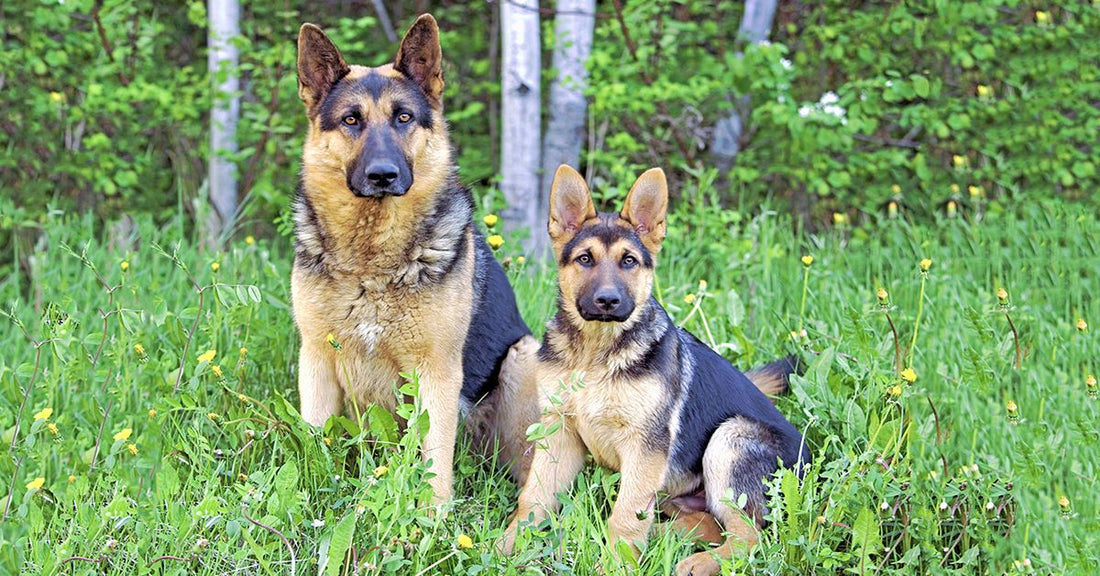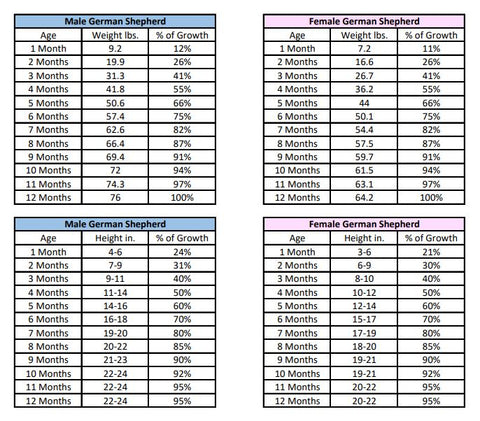The Development Stages and Growth Chart of German Shepherds

German shepherds are athletic, muscular, herding dogs. They are meant to be agile, quick, and have lots of endurance. These high energy dogs excel at both work and play but need one or the other to be fulfilled.
From birth to old age, they go through many growth stages. Their health and temperament is influenced on their genetics as well as the love, care, nutrition, training, and socialization they receive.
Just as there are many colors of the German shepherd, it is common to see many sizes. However, according to the American Kennel Club, the breed standard is 24”-26” for males and 22”-24” inches for females. Once full grown, males should weigh between 65-90 pounds and females should weigh 50-70 pounds. Both sexes should be longer than they are tall.
What does the “breed standard” that they are idealized by mean? According to the American Kennel Club, the definition of breed standard is the “description of the ideal dog of each recognized breed, to serve as an ideal against which dogs are judged at shows, originally laid down by a parent breed club and accepted officially by national or international bodies.”
Since there are several lines, such as German working lines and American show lines, and numerous breeders of German shepherds, this ideal is not always maintained. It’s not uncommon to see dogs larger than 100 or more pounds, and some owners actually seek out and prefer these larger dogs.
As puppies, their full grown size is determined by their genetics but for the most part, their developmental stages will be similar between dogs. The following is a guide for German shepherd development:
Neonatal Period
Birth to 3 weeks – newborn puppies are born blind, deaf, and helpless. They rely on their mother for nourishment, warmth, and elimination. During this time, they experience these milestones:
Birth to 2 weeks:
- Nursing
- Birth weight doubling by 2 weeks
2 weeks – 3 weeks:
- Puppies start to stand
- Eyes and ears fully open
- First baby teeth begin coming in
- Start trying to walk
Socialization Period
The socialization period is from 3 weeks to 12 weeks. During this time, puppies begin learning social skills while still with their mother. Their mother and other puppies teach them important skills during this stage that will prepare them for life with their future owners. During this time, they will experience these milestones:
3 weeks – 4 weeks
- Walking improves
- Plays with littermates and humans
- Teeth finish erupting
5 weeks – 8 weeks
- Begin eating dog food
- Early socialization window such as greeting littermates, people, new things
- Fear reactions begin
- Weaning begins around (7-8 weeks)
8 weeks – 12 weeks
- Weaned from mother
- Activity increases
- House training starts
- Ears begin to stand
- Training begins
- Correct guarding behavior
Juvenile Period
4 months – 6 months
German shepherds begin losing their puppyhood and becoming more childlike at 4 months. They are now ready to go to their new homes and can start puppy training and begin perfecting housetraining yet still can’t hold it very long. The childhood period lasts from 4 – 6 months and lots of socialization and positive reinforcement should happen during this important, formative time. In this period puppies will:
- Have all puppy teeth, start getting adult teeth at 4 months
- Playful and full of energy
- Improve their motor skills
- Develop their future social skills
- Become fully housetrained
- Be constantly learning
- Need continual training, socialization and new experiences
- Begin sonority period in which they will test boundaries and may become stubborn
Adolescent Period
6 months – 2 years
The adolescent period begins around 6 months and lasts until they are around 2 years old. During this time, dogs reach their sexual maturity and are very active. By two they will have reached their full size but will continue to fill out a bit. They may continue to test boundaries to see what they can get away with. They lose their puppy look and become grown dogs. Some dogs may go through a second fear period and some may suddenly seem to forget their training. These stages are normal and with training, exercise, confidence building, and bonding with their family, can be easily overcome.
- Lose puppy appearance
- Are rambunctious
- May go through a second fear period
- Continue to need socialization
- Reinforce training
- Continue new experiences
- Establish boundaries
- Reach sexual maturity
Adulthood
2 years – 3 years
By the time a German shepherd reaches adulthood at 2 – 3 years old, they will have reached their full size but may fill out more. They should continue to be an active dog and loves exercise and attention. They can continue to learn new things and enjoy training and new experiences.
- Fully trained but still trainable
- Now a calmer less impulsive
- Confident member of the family
- Still active but not as hyper
Senior Years
9 years – 12 years
Depending on how well they’ve been cared for, German shepherds live 9 – 13 years. They typically reach their senior years around 8 – 10 years old. This is the time of life where their comfort and health needs to be attended to and health issues become more apparent. In this phase of life senior dogs will:
- Begin to slow down yet may still be playful
- Are calmer and rest more
- May need supplements or pain control for arthritis, spine and joint problems
- Can benefit from senior food or sensitive digestion foods
- Continue to enjoy some form of exercise but jumping and hard play should be avoided
- Should be monitored by a vet and watched for worsening symptoms

We hope that you find this information about the growth of your German shepherd helpful. Please feel free to share with your family and friends.
























